| EXHIBITIONS NEWS PRESS ABOUT US CONTACT |
|||||
| REPRESENTED ARTISTS | BERTILLE BAK | GWENAEL BELANGER | DEXTER DYMOKE | ANTTI LAITINEN | |
| MARKO MAETAMM | YUDI NOOR | OLIVER PIETSCH | KIM RUGG | ||
| BETTINA SAMSON | SINTA WERNER | ||||
YUDI
NOOR
Between the Bars
23 OCTOBER - 5 DECEMBER 2010
VIEW WORKS
NETTIE HORN is pleased to present a solo exhibition by Berlin-based artist Yudi Noor, featuring a new body of sculptural works in the form of an installation as well as a new series of collages.
Through the use of diverse sourced
materials and objects, Yudi Noor creates arrangements in a minimalist
form of language exploiting notions of symbolism issued from cultural,
religious, social and political fields. Noor’s work can be seen
as a reaction to the themes and tendencies of our society, exploring
questions of spirituality, belief, myths and their contexts within
individual and collective notions of life practice.
Born in Indonesia, Noor's origins in a culture which advocates religious
pluralism and the idea of "unity among diversity" is a main characteristic
which influences his practice. “Between the Bars” presents
a new series of assemblage and collage, relating the history of Islam
through visual story telling. Materials and elements from diverse origins
and eras translate these re-imagined stories; sacred wood, stone,
formed metals, and neon, are organized in compositions which reveal
themselves through orders of a colourful and abstract nature. Here,
Noor reflects on the origins and foundations of cultures as possible
interpretations to the orders of complexities in contemporary thought.
Generated by a spontaneous and semi-autonomous approach to a daily ritual, Noor’s pieces are inhabited by a range of elements which have followed their own journey according to their histories and context. As Noor states “in a process of space and time, of proportion and direction, materials are brought together”. Determined by conditions of given origins and qualities, each object composing these sculptures and installations contributes to the way each work develops.
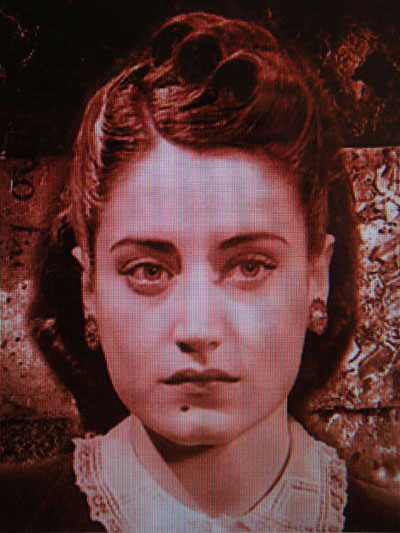
Noor’s
collages reflect on memory and collective experience, presenting elements
collected in places he has visited, such as embroidery, ornamental
glass, ink-jet prints, and tape. These collages are manifest to the
fragmentary nature of today’s daily situation, geometric shapes
symbolizing elements of the fundamental human condition.
Yudi Noor was born in 1971 in Java, Indonesia. He
lives and works in Berlin.
Exhibitions include, “Mixed Opera”, Brigit Ostermeier,
Berlin (SOLO SHOW) (2010); “Inkonstruktion”, Art Biesenthal,
Germany (2010); “We have time”, Kunstverein Arnsberg (SOLO
SHOW) (2009); Galerie Brigit Ostermeier, Berlin (SOLO SHOW) (2009); Let's
go home, S-Kai, Am Sandtorkai 50, Hamburg, 2009; EINZUEINS RÜGEN
- Skulpturensommer, Rügen, Germany (2008).
For inquiries regarding availability of works and prices, or additional information about the artist, please contact the gallery.
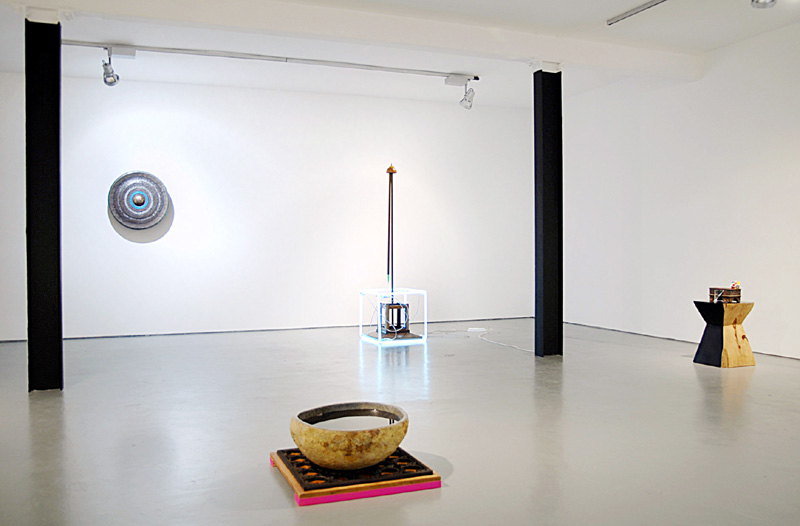
Installation View, Yudi Noor, Between the Bars, NETTIE HORN
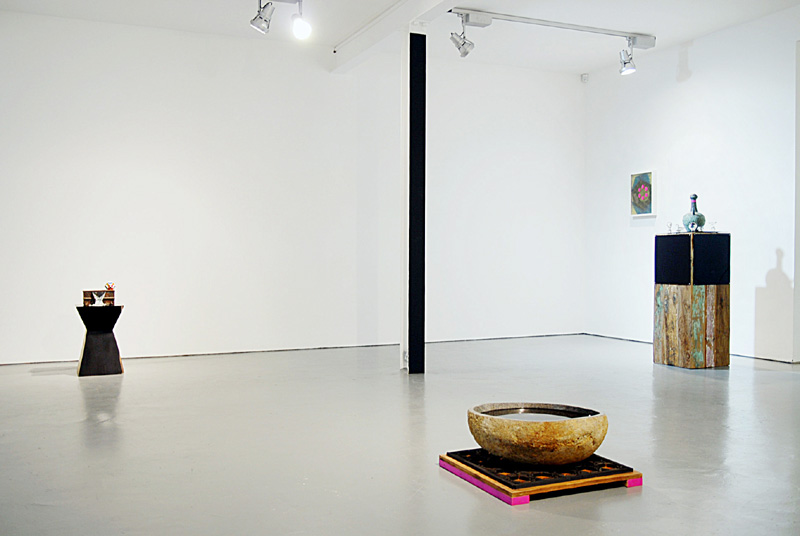
Installation View, Yudi Noor, Between the Bars, NETTIE HORN
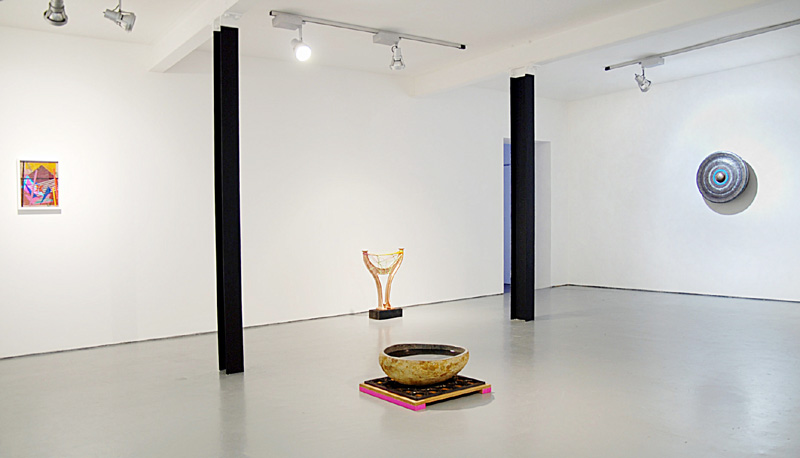
Installation View, Yudi Noor, Between the Bars, NETTIE HORN
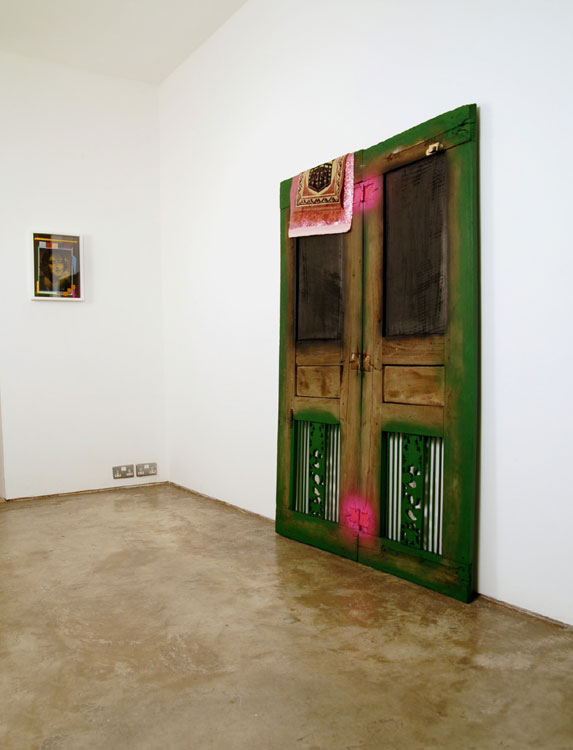
Installation View, Yudi Noor, Between the Bars, NETTIE HORN
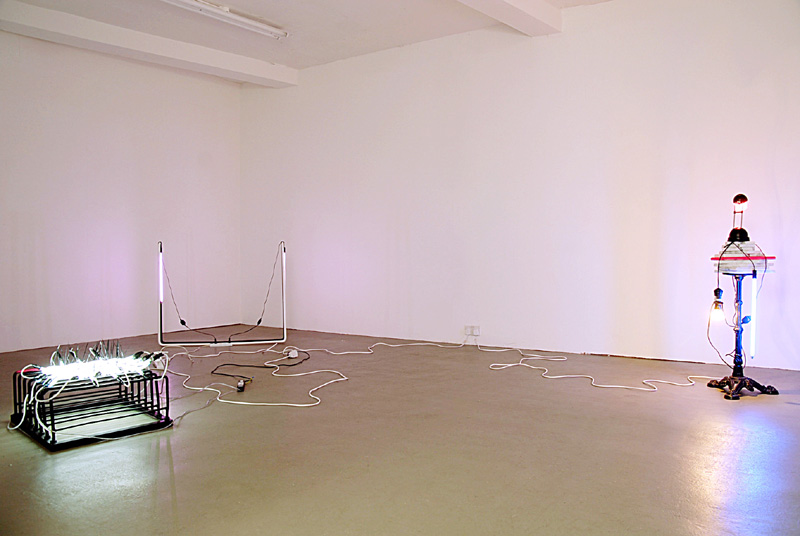
Installation View, Yudi Noor, Between the Bars, NETTIE HORN
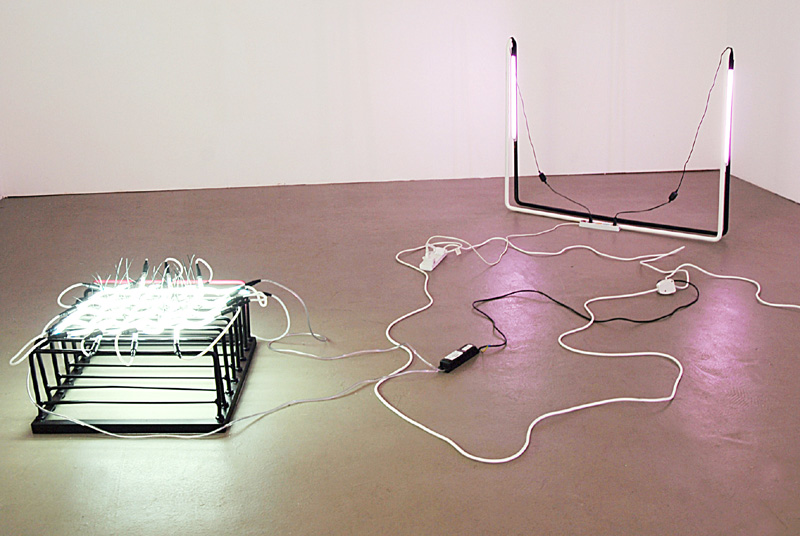
Installation View, Yudi Noor, Between the Bars, NETTIE HORN
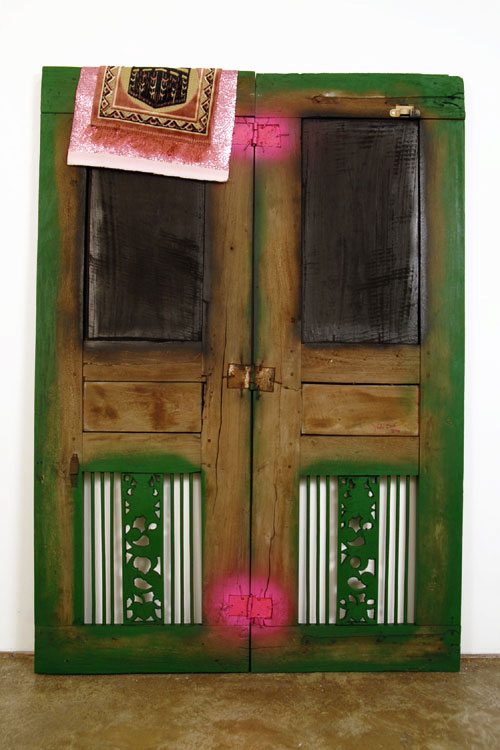
Enter Commune, 2010
Teak wood, spray paint, canvas, rug and steal
118.5 x 167.5 cm
Enter commune is composed of
an old traditional Javanese wooden door and a prayer carpet positioned
onto a glittery fabric found on the stage of
The Deutsch Opera theatre
in Berlin. The door, upside down and turned to the back, hides the
elaborate wood carving which is a record of the hand worker.
This
work is based on the idea of circulation and cyberspace in a world
in which our privacy and communication is secured by passwords and
other formulas.
The colour green is used here as a symbol of Islam
- representing the freshness of a healthy spiritual lifestyle.
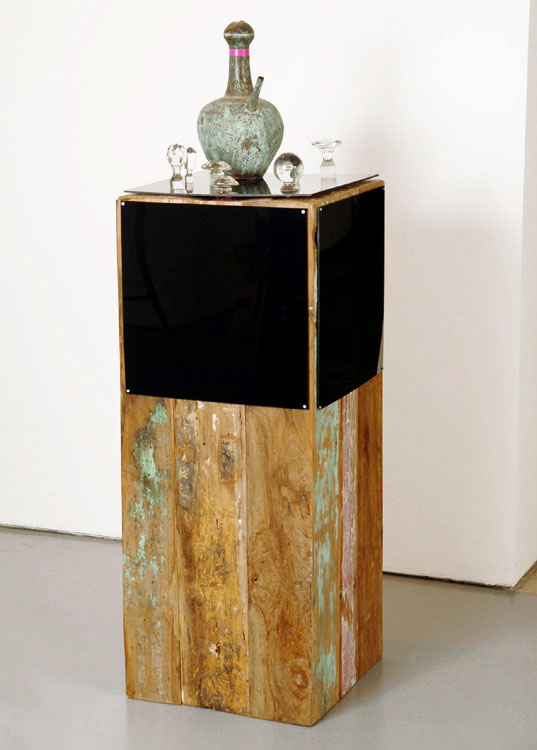
Breaking the Water Picture,
2010
Jug, glass, Plexiglas and teak wood
132 x 40 x 40 cm
In Breaking the Water Noor has positioned the Venetian
handmade glass caps according to a stellar constellation - their geometric
shapes (hexagon, octagon and pentagon)
recall the omnipresence of mathematics
in a number of religions. These caps accompany an ancient jug which
was once used in everyday activities in Java and which, according to
Indonesian beliefs, had the vocation of collecting the spiritual ghost
believed to be a benefactor and advisory spirit. The black plexiglas
surfaces form a cube within the proportions of a tall wooden plinth
made from old Javanese boats. This work is politically charged in the
way the artist recalls a time when the water was holy and pure,
and
before it became a profitable industry coinciding with the pollution
and waste from over-industrialization.
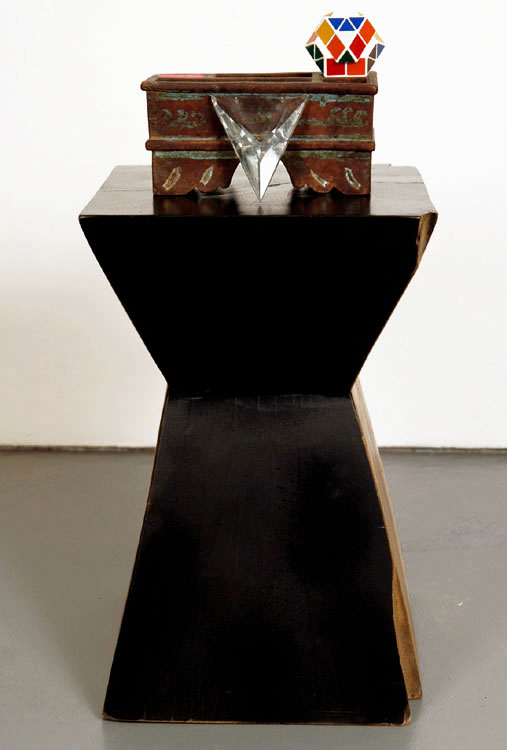
Joglo, 2010
Tamarind and teak wood, Rubix cube, spray paint, crystal glass and
modelling clay
67 x 34 x 32 cm
Joglo is the name of the traditional
Javanese house and is composed as such with an element made of tamarind
root from the supporting structure,
a medicine box which belonged
to the artist’s
grand-mother, a Venetian glass charm as well as a new-generation Rubik’s
cube.
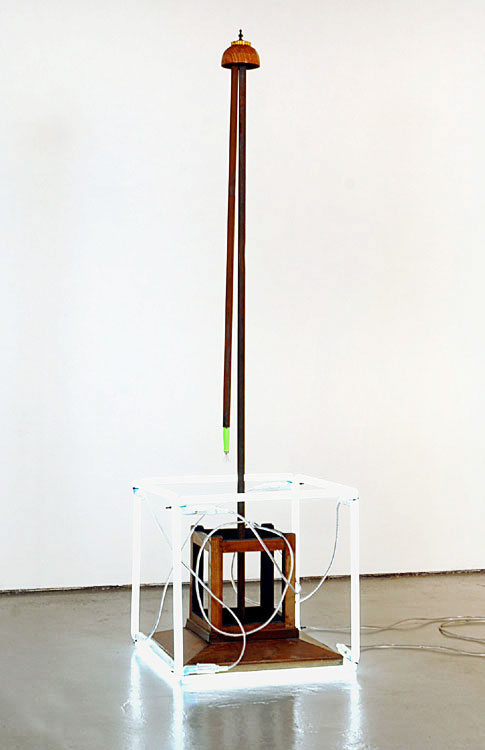
Entering to Nothing
Else, 2010
Neon light, transformer, teak wood, steal, plastic, tape and zinc
180 x 53 x 53 cm
The diversity of objects and material presented in Entering
to Nothing Else, neon light, steel, a rice bowl, papaya
peeler and part of a table, form a temple composition.
As
Noor describes, “your truth, my truth, and the true itself,
if in harmony lead to nothing else, an emptiness of self and an acceptance
of the other.”
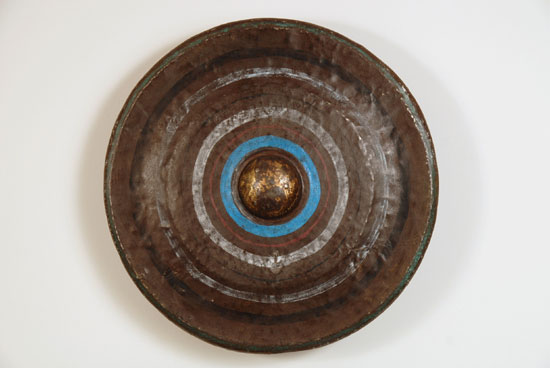
Hong Wilaheng, 2010
Old gong, paint, pen and cord
63 x 63 x 28 cm
Hong Wilaheng is a metal gong
which once belonged to a Javanese community. It was commonly used
during trans-dances and other rituals aimed to call the spirits.
This work is an invitation to think about the notion of animism – that an animate presence
is inherent in natural elements and objects as well as living beings.
A
number of circles have been painted onto the object as symbolising
the theosophical doctrine of “no end and no beginning”,
and for an awakening, “do not double what is one”.
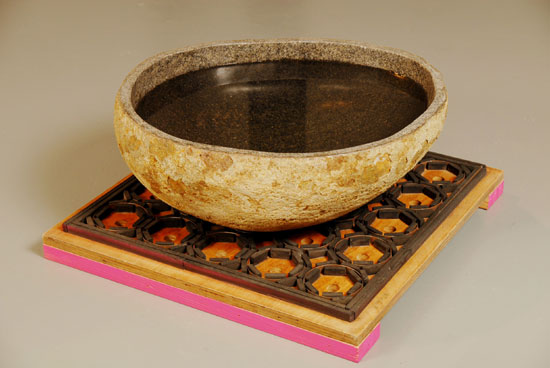
Star Became Sphere, 2010
Volcano roc, wooden box, rubber, metal and spray paint
27 x 57 x 52 cm
Star Becomes Sphere is a carved
river stone, composed of ancient volcanic rock from the Merapi volcano
in Java. Filled
with water, the piece initiates reflection.
Resting on the base of
its shipping crate, with a hexagonal design, the work shifts an interior
design product association
made with
spiritual materialism to the physical
and mystical presence of elements.
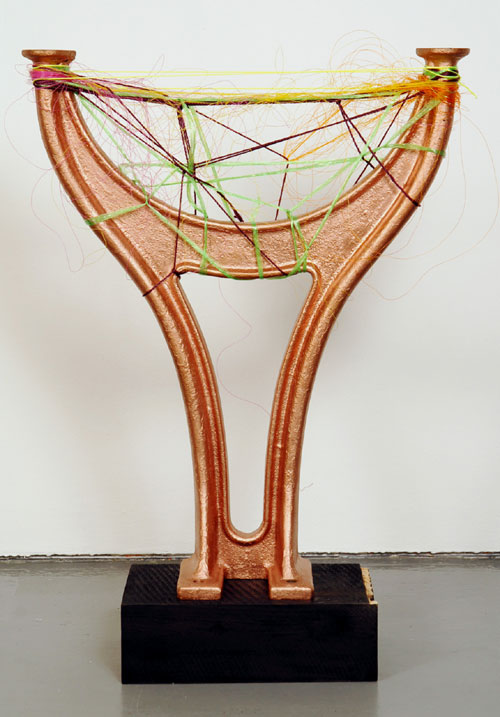
Ypsilon, 2010
Steal, copper, wood, spray paint, strings, plastic and nylon
73 x 53 x 20 cm
Ypsilon is composed of an unidentified
iron form found in the trash outside a synagogue in Berlin. Iron
is the most common element found on earth and this
work questions
its origin and the enigma behind the way in which it was originally
transformed into its solid state. It is covered with copper spray.
The
strings
and other bands are a light material wrapped and bound in
an arc of the object as a metaphor for the function of thought.
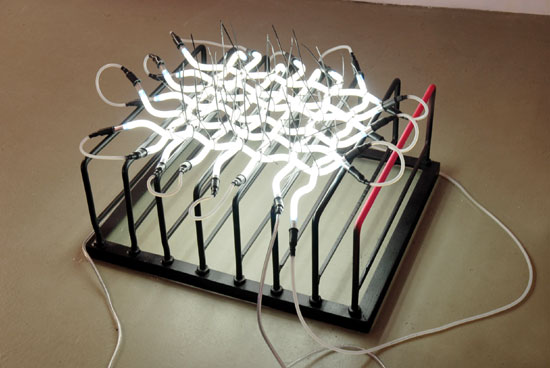
The Bars, 2010
Neon light, steal and spray paint
40 x 54 x 62 cm
The Bars an outdoor steel design, is woven by fragile neon light – poetic security.
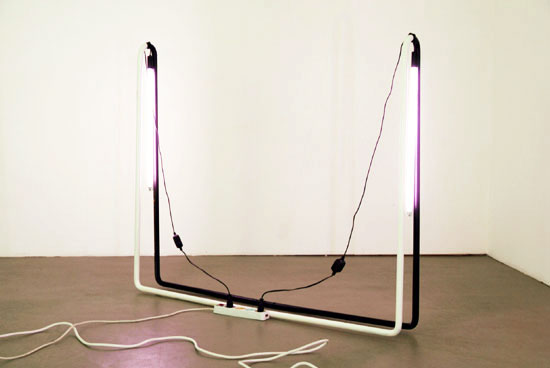
Double standard, 2010
Steal, spray paint and neon light
54 x 25 x 62.5 cm
Double Standard refers to any set of principles containing
different provisions for one group of people than for another, typically
without a good reason
for having said difference. In this work, Noor
refers to the colonisation of Asia and Africa with their troubled pasts
due to the expanse of imperialism.
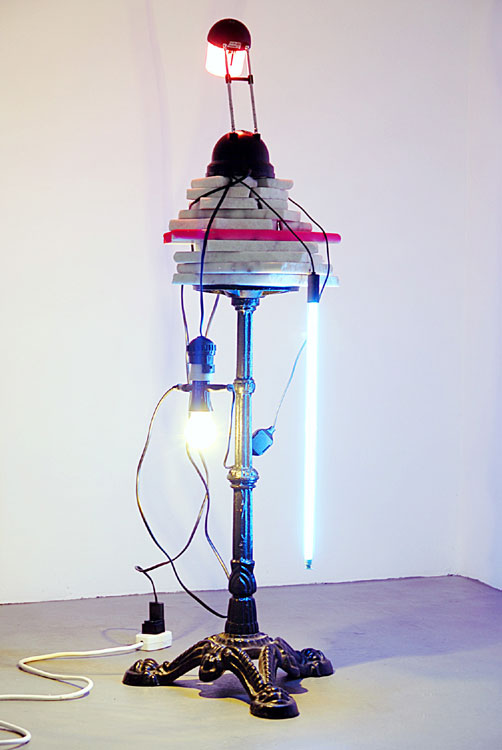
Don’t know who it was, 2010
Steal, marble, lamp, bulb, neon and spray paint
111 x 14 x 93.5 cm
Don’t know who it was is
composed of a French café table found in Vienna alongside
a symbolic combination of three different light sources.
The blue
neon light is used as the system to verify the authenticity of bank
notes while the Edison bulb refers to the origin of the expansion
of industrial light -
this light bulb will soon be redundant and
replaced by the current energy-efficient light bulbs; the reading
lamp is a direct reference to learning and knowledge.
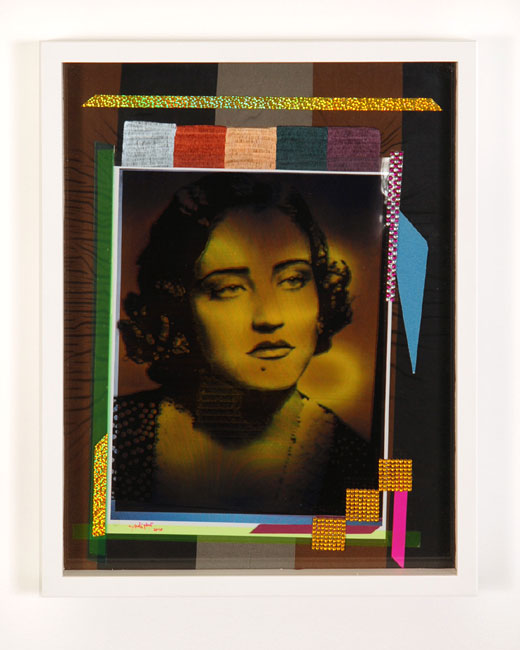
Ya Toyour Asmahan, 2010
Embroidery on fabric, photo, inkjet print on transparent paper, sand
paper,
adhesive tape, cardboard, cell phone, sticker on glass,
frame
42 x 32 x 5 cm
Ya Toyour Asmahan is a tribute
to the Syrian-Egyptian singer Asmahan (1918-44) who was well known
for her powerful voice and charisma.
“Ya Toyour” is one of her most recognised
love songs. Asmahan’s presence orchestrates the whole exhibition
as an emblem of strength, beauty and mysticism.
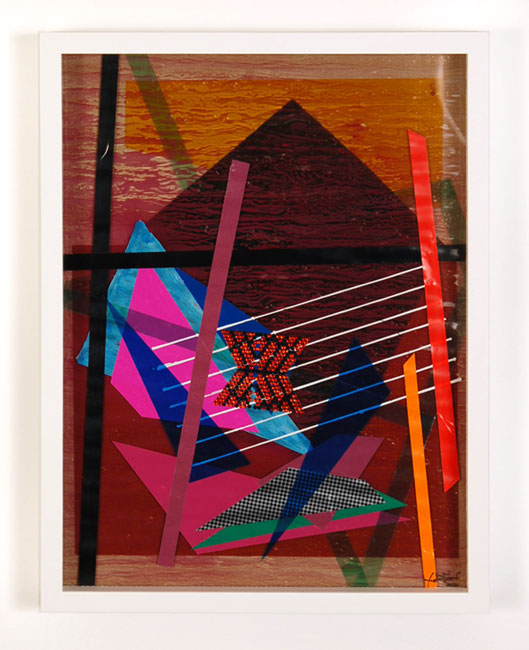
Akhenaton, 2010
Ornamental glass, sand paper, tape, cell phone stickers, spray paint
and frame
42 x 32 x 5 cm
The collage Akhenaton draws on history from the Egyptian
king Akhenaton whose ideology reformed Egyptian polytheistic beliefs
to
spread the modern idea of monotheism. The black tone as well as
the vibrant colours here characterise Akhenaton’s jewels.
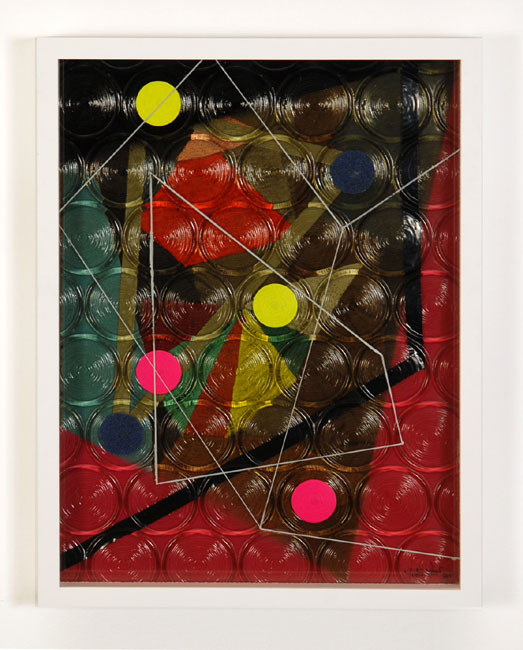
New Book, 2010
Ornamental glass, spray paint, sand paper, tape, embroidery, frame
42 x 32 x 5 cm
New Book refers to the notions of category and codes, and a concurrent order that could evoke equality and liberation from all rules.
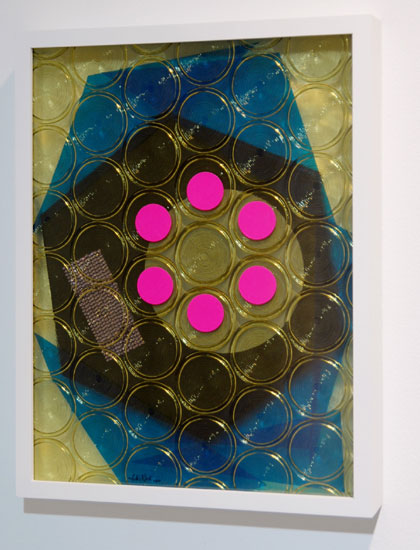
Revolver, 2010
Ornamental glass, canvas, ink, tape, cell phone stickers, cardboard and frame
42 x 32 x 5 cm
The collage Revolver is an effect in materiality, the relationship between attraction and repulsion.
© NETTIE HORN